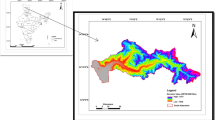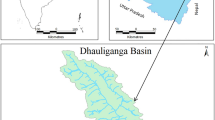Abstract
Considering the severity of a catastrophic flood in the Teesta river in India earlier, it is indispensable to assess the runoff at the basin’s ungauged outlet, Mekhliganj. Almost every other year, the downstream of the river is in spate during the monsoon months. Among the three gauging stations in the basin, Teesta Bazaar, Domohani, and Mekhliganj, streamflow data is unavailable at the latter one. In this context, this study focuses on estimating the runoff of the Teesta river basin at its outlet, Mekhliganj, using Hydrologic Engineering Center-Hydrological Modeling System (HEC-HMS) software, verifying the output from the model through the measured streamflow data at the other two upstream gauging locations, Teesta Bazaar and Domohani. The runoff has been estimated for daily precipitation from May to October, applying Soil Conservation Service (SCS), curve number (CN), and SCS unit hydrograph method. Subsequently, the model has been calibrated for 2001 and 2006 to optimize both the Muskingum routing parameters. The model has been validated for some specific years like 2004, 2012, 2013, and 2016, which experienced extreme deluge. The results for both the upstream gauging stations bear a good correlation between the computed and observed data, evaluated through the statistical indicators such as percentage error in peak flow (PEPF), percentage error in volume (PEV), Nash-Sutcliffe (NSE), and R2, consequently justifying the simulated result at the outlet. This study is necessary for this vast watershed area with limited gauging stations and an ungauged outlet to understand the basin response and its derived consequence.














Similar content being viewed by others
Data availability
Not permitted to disclose.
References
Abdulkareem JH, Sulaiman WNA, Pradhan B, Jamil NR (2018) Relationship between design floods and land use land cover (LULC) changes in a tropical complex catchment. Arab J Geosci 11(14). https://doi.org/10.1007/s12517-018-3702-4
Adib A, Salarijazi M, Najafpour K (2010) Evaluation of synthetic outlet runoff assessment models. J Appl Sci Environ Manag 14(3):13–18. https://doi.org/10.4314/jasem.v14i3.61450
Blöschl G (2005)Rainfall-runoff modeling of ungauged catchments. In: Encyclopedia of Hydrological Sciences. Edited by M G Anderson. Wiley, Amsterdam, Rainfall-Runoff Modeling of Ungauged Catchments.
Chatterjee M, Roy D, Das S, Mazumdar A (2014) Assessment of water resources under climate change: Damodar river basin, India. ARPN J Eng Appl Sci 9:2183–2191
Dastorani TM, Khodaparast R, Talebi A et al (2011) Determination of the ability of HEC-HMS model components in rainfall-run-off simulation. Res J Environ Sci 5:790–797
Derdour A, Bouanani A, Babahamed K (2018) Modelling rainfall runoff relations using HEC-HMS in a semi-arid region: case study in Ain Sefra watershed, Ksour Mountains (SW Algeria). J Water L Dev 36:45–55. https://doi.org/10.2478/jwld-2018-0005
Eljack IH, Rahim Elhag A, Fadlalla Elsheikh R (2015) Streamflow analysis using GIS techniques and HEC-GeoHms. Int J Eng Invent 5:05–13
Feldman AD (2000) Hydrologic modeling system HEC-HMS, technical reference manual. US Army Corps of Engineers, Hydrologic Engineering Center, Davis, CA., USA.
Gebre SL (2015) Application of the HEC-HMS model for runoff simulation of upper blue Nile river basin. J Waste Water Treat Anal 06:199. https://doi.org/10.4172/2157-7587.1000199
Gharib M, Motamedvaziri B, Ghermezcheshmeh B, Ahmadi H (2018) Evaluation of ModClark model for simulating rainfall-runoff in Tangrah watershed, Iran. Appl Ecol Environ Res 16:1053–1068. https://doi.org/10.15666/aeer/1602_10531068
Goyal MK, Goswami UP (2018) Teesta river and its ecosystem. In: Singh D (ed) The Indian Rivers. Springer Hydrogeology. Springer, Singapore, pp 537–551. https://doi.org/10.1007/978-981-10-2984-4_37
Halwatura D, Najim MMM (2013) Application of the HEC-HMS model for runoff simulation in a tropical catchment. Environ Model Softw 46:155–162. https://doi.org/10.1016/j.envsoft.2013.03.006
He Y, Bárdossy A, Zehe E (2011) A review of regionalisation for continuous streamflow simulation. Hydrol Earth Syst Sci 15:3539–3553. https://doi.org/10.5194/hess-15-3539-2011
Ibrahim-Bathis K, Ahmed SA (2016)Rainfall-runoff modelling of Doddahalla watershed—an application of HEC-HMS and SCN-CN in ungauged agricultural watershed. Arab J Geosci 9:1–16. https://doi.org/10.1007/s12517-015-2228-2
Jia Y, Zhao H, Niu C, Jiang Y, Gan H, Xing Z, Zhao X, Zhao Z (2009) A WebGIS-based system for rainfall-runoff prediction and real-time water resources assessment for Beijing. Comput Geosci 35:1517–1528. https://doi.org/10.1016/j.cageo.2008.10.004
Lastoria B, Grafiche Futura T (2008) Hydrological processes on the land surface: a survey of modelling approaches. FORALPS Technical Report 9. Trento, Italy.
Mandal SP, Chakrabarty A (2016) Flash flood risk assessment for upper Teesta river basin: using the hydrological modeling system (HEC-HMS) software. Model Earth Syst Environ 2:1–10. https://doi.org/10.1007/s40808-016-0110-1
McCarthy GT (1938) The unit hydrograph and flood routing. In Proceedings of Conference of North Atlantic Division, Washington, WA, USA.
Moriasi DN, Arnold JG, Van Liew MW, et al. (2007) Model evaluation guidelines for systematic quantification of accuracy in watershed simulations. Trans ASABE. https://doi.org/10.13031/2013.23153
Nandalal HK, Ratnayake UR (2010) Event based modeling of a watershed using HEC-HMS. ENGINEER 53:28–37
Najim MMM, Babelb MS, Loofb R (2006) AGNPS model assessment for a mixed forested watershed in Thailand.https://doi.org/10.2306/scienceasia1513-1874.2006.32.053
Natarajan S, Radhakrishnan N (2021) Simulation of rainfall–runoff process for an ungauged catchment using an event-based hydrologic model: a case study of koraiyar basin in Tiruchirappalli city, India. J Earth Syst Sci 130:1–19. https://doi.org/10.1007/s12040-020-01532-8
Nash JE, Sutcliffe JE (1970) River flow forecasting through conceptual models. Part 1: a discussion of principles. J Hydrol 10:282–290
Perry S, Hamann A (2013) Utilizing GIS as a tool in mapping impervious surfaces and protecting southeast Michigan’s headwaters. https://proceedings.esri.com/library/userconf/proc98/proceed/to450/pap448/p448.htm. Accessed 30 Aug 2019
Rostami N, Saleh A, Ghobad R, Noredin R (2011) Evaluation of HEC-HMS methods in surface runoff simulation (Case study: Kan watershed, Iran). Adv Environ Biol 5:1316–1321
Roy Suprakash (2011) Flood hazards in Jalpaiguri district and its management. Phd thesis, University of North Bengal, Darjeeling, West Bengal.
Sabzevari T, Ardakanian R, Shamsaee A, Talebi A (2009) Estimation of flood hydrograph in no statistical watersheds using HEC-HMS model and GIS (case study: Kasilian watershed). J Water Eng 4:1–11
SCD (1972) ‘Handbook of hydrology,’ Soil Conservation Department, Ministry of Agriculture, New Delhi.
Scharffenberg B, Bartles M, Brauer T, et al. (2018) Hydrologic modeling system HEC-HMS user’s manual version 4.3. US Army Corps of Engineers, Hydrologic Engineering Center, Davis, CA., USA.
Scharffenberg W, Fleming M (2010) Hydrologic modeling system HEC-HMS user’s manual version 3.5. US Army Corps of Engineers, Hydrologic Engineering Center, Davis, CA., USA.
Shahid MA, Boccardo P, Usman M, Albanese A, Qamar MU (2017) Predicting peak flows in real time through event based hydrologic modeling for a trans-boundary river catchment. Water Resour Manag 31:793–810. https://doi.org/10.1007/s11269-016-1435-2
Sitterson J, Knightes C, Parmar R, et al. (2017) An overview of rainfall-runoff model types an overview of rainfall-runoff model types. United States Environmental Protection Agency. pp 1–30.
Subramanya K (2008) Engineering hydrology, Publisher Tata McGraw Hill, 3rd edition, New Delhi.
Tassew BG, Belete MA, Miegel K (2019) Application of HEC-HMS model for flow simulation in the lake Tana basin: the case of Gilgel Abay catchment, upper blue Nile basin, Ethiopia. Hydrology 6:1–17. https://doi.org/10.3390/hydrology6010019
USDA (1986) Urban hydrology for small watersheds, second ed, technical release 55. United states Department of Agriculture. Natural Resources Conservation Service, Conservation Engineering Division, Washington, D.C.
Wale A, Rientjes THM, Gieske ASM, Getachew HA (2009) Ungauged catchment contributions to Lake Tana’s water balance. Hydrol Process 23:3682–3693. https://doi.org/10.1002/hyp.7284
Xu C (2002) Text book of hydrologic models. Uppsala University, Sweden
Yang WY, Li D, Sun T, Ni GH (2015)Saturation-excess and infiltration-excess runoff on green roofs. Ecol Eng 74:327–336. https://doi.org/10.1016/j.ecoleng.2014.10.023
Acknowledgments
The authors duly thank the Central Water Commission, New Delhi, India Meteorological Department, Pune, National Bureau of Soil Survey and Landuse Planning (NBSS & LUP), Kolkata, and Copernicus Programme operated by the European Space Agency for furnishing the data support to carry out this study.
Author information
Authors and Affiliations
Contributions
Swarnadeepa Chakraborty and Sujata Biswas contributed to the study conception and design. Material preparation, data collection, and analysis were performed by Swarnadeepa Chakraborty. The first draft of the manuscript was written by Swarnadeepa Chakraborty, and Sujata Biswas commented on the previous version of the manuscript. All authors read and approved the final manuscript.
Corresponding author
Ethics declarations
Ethics approval
Not applicable.
Consent to participate
Not applicable.
Consent for publication
Yes.
Conflict of interest
The authors declare that they have no competing interests.
Additional information
Responsible Editor: Broder J. Merkel
Rights and permissions
About this article
Cite this article
Chakraborty, S., Biswas, S. Simulation of flow at an ungauged river site based on HEC-HMS model for a mountainous river basin. Arab J Geosci 14, 2080 (2021). https://doi.org/10.1007/s12517-021-08385-5
Received:
Accepted:
Published:
DOI: https://doi.org/10.1007/s12517-021-08385-5




